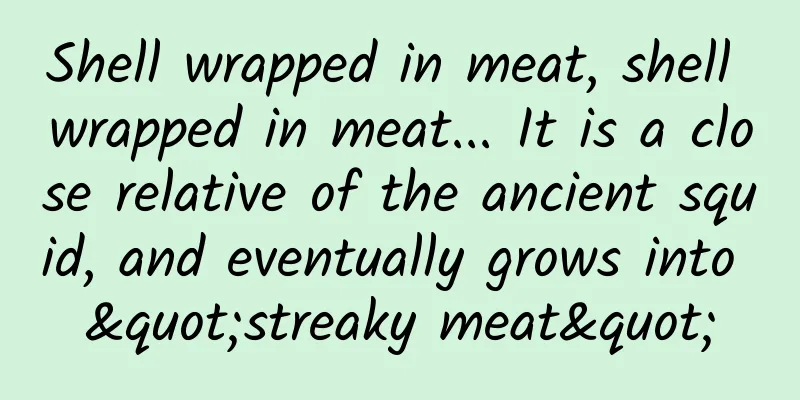Shell wrapped in meat, shell wrapped in meat... It is a close relative of the ancient squid, and eventually grows into "streaky meat"

|
In nature, animals' hard structures basically have only one layer. The shells of crabs and prawns are tough and difficult to chew, but after peeling the shells, there is boneless meat inside; pork and chicken have no bones on the outside and can be eaten directly, but they have very hard bones inside to support them, and you may bite into the bone fragments if you are not careful; squid is even more convenient, just pick out the hard beak and a long strip like a plastic sheet, and there is no hard object left, so you can gobble it up. Invertebrates such as shrimp, crab, snail, and shellfish have meat wrapped in shells, while vertebrates have meat wrapped in "shells". Whether you peel the shells first or remove the bones later, you only need to spend energy once. There are very few troublesome things that have a "nesting doll structure" with meat in the shell, shell in the meat, and meat in the shell, but the ancient relatives of squids, ammonites, are such a strange species. Most invertebrates have no hard parts after the shell is peeled off. 1. Shell wrapped in meat: add "armor" for protection Ammonites belong to the class Cephalopoda of the phylum Mollusca. Like modern squids, they are mollusks with 10 long tentacles, behind which are squid-like eyes, a head and a long cylindrical body. Unlike squids, they do not have long chitin plates. Instead, they have a large calcium hard shell on the outside of the squid tube , forming a shell-wrapped meat structure, making them look like a nautilus with a squid head. Although they look very much like nautiluses, they have the same ancestor as squids and separated from the nautilus during the Cambrian period and began to evolve independently. Therefore, they are closer to squids, cuttlefish, octopuses and other coleoids that have no shell or only have a shell inside. Ammonites are like nautiluses with squid heads. Image source: Wikipedia Since ammonites and squids have the same ancestor, why do ammonites have shells and squids only have a long chitin plate? This is a choice made by the two to adapt to different lifestyles. Ammonites retained a relatively heavy shell, and although they were protected by the shell, they could not swim quickly due to the weight of the shell. Squids adapted to a fast-swimming lifestyle. During the evolution process, their ancestors gradually turned the soft part outward and wrapped the shell inside the body, forming a structure of flesh wrapped in shell. In this way, they use their smooth soft bodies to meet the water flow, reduce resistance and increase speed. After the outer shell becomes the inner shell, it loses its function of protecting the body, and its weight also affects the swimming speed of the squid, so it gradually degenerates during evolution. Today, the original outer shell of the squid is only a thin long piece, which is only used to attach muscles, reducing weight to the greatest extent. The ancestors of ammonites and squids also lived together. This picture depicts the squid's ancestor, Anchisquid (right), preying on an ammonite (left). Image source: Reference [6] In ancient times, there were few organisms capable of destroying the shells of ammonites, so ammonites multiplied in large numbers. Their population even exceeded that of fish, making them the most numerous species in the ocean. But after entering the Cretaceous period, with the evolution of modern armored fish, crabs and other species, the protective power of the ammonite "armor" gradually weakened, and its weight restricted their swimming, putting them gradually at a disadvantage in the competition. In order to save their tribe, ammonites used various tricks: some began to grow larger , using their huge bodies to scare away predators; some twisted their shells and hung on seaweed to wait for prey; and a few ammonites learned the method of their fellow squids and tried to flip the soft part out of the shell . Although they tried their best, their attempts did not seem to be satisfactory... Fossil of a pleated ammonite, whose shell resembles a twisted sausage. Image source: Reference [2] 2. Meat wrapped in shell: An attempt at reform during an ethnic crisis In the Aptian strata of Russia, scientists discovered a Cretaceous ammonite, the pleated ammonite, whose fossils include three intact shells and about 100 shell fragments. They were surprised to find that this ammonite is very different from other ammonites. The shell of this ammonite is broken in the middle, probably to reduce its own weight , but the fluid pipe inside is not connected at the broken part, and remains open, directly in contact with seawater. If it were an ordinary ammonite, it would die due to loss of body fluids, but this ammonite shows no signs of death, so there is only one reason - the soft part that cannot be preserved in the fossil closed the fracture. As shown in the figure below, after a period of time, the fracture of this ammonite was closed by the back wall of the second and third vertical shells that grew out. These two vertical shells became thicker at the fracture of the first vertical shell and extended to the middle, surrounding the fracture. In the surrounded part, scientists also found a large number of fragments produced when the shell broke, which were also preserved in the new shells that grew out later, indicating that some tissues wrapped these fragments and prevented them from falling off. The first vertical shell (dw1) of the ammonite is broken, with a large number of fragments (f) appearing. The fluid infusion pipe (sip) is open and is only closed when the back wall of the second vertical shell (dw2) and the third vertical shell (dw3) thickens. Image source: Reference [1] In addition, there are some fine structures supporting the soft body outside the ammonite shell. There are fine holes on the broken shell wall, which penetrate part of the shell and are about 1 mm in diameter, which may be connected to the outside world. At the same time, there are long and sharp traces of large muscle attachment on their shells. The traces are far away from the growth line and relatively close to the shell opening, which suggests that the roots of the soft body may be attached very close to the shell opening, and most of them are located outside the shell opening. An Aptian ammonite, Aconeceras, has traces of muscles attached to the outside of the shell, and may also have flesh wrapped around the shell. The "shell-wrapped flesh" structure of the pleated ammonite may also be similar to this. Image source: Reference [2] Now, we can imagine what they look like. They are like the nautilus wrapped in a layer of squid skin, with a structure of flesh wrapped in shell and then flesh wrapped in shell : the outermost soft body protects the shell, and the shell protects the internal organs. If you still can't imagine it, then think back to the process of eating a soft-shelled turtle: the outermost skirt is soft and glutinous, and after eating the skirt, the hard ribs inside are transformed into a shell. When you open the shell, the internal organs and meat inside are fresh, mellow, and tender, which is a beautiful sight. I guess the ammonites that have evolved to this level also taste like this. You can imagine the ammonite as a turtle, with a structure of flesh wrapped in a shell and flesh wrapped in a shell. Image source: Wikipedia 3. Shell wrapped in meat, shell wrapped in meat: Conservatism prevails after all However, they are not done yet. Unlike squids, which internalize their outer shells and then degenerate them into long chitin sheets to reduce weight and increase speed, ammonites grow a new shell on top of the soft shell . The shells are mainly composed of a thin layer of nacre rich in organic matter. The nacre at the mouth of the common ammonite shell contains more hard prismatic layer structures and less organic matter to enhance the shell strength, which is needed for shells exposed to the outside. But the prismatic layer of the shell mouth of the ammonite is only 2 to 3 layers of nacre, which is 35 times thinner than the nacre in a fully grown shell. Nautilus Shell Macro Closeup Isolated by Csphoto Instead, the shell mouth of the ammonite has an additional shell layer on the outside, like a Russian nesting doll, with a large shell inside a small shell. In common ammonites, as approaching the shell opening, the growth lines of the nacre in the ammonite shell become more and more inclined toward the shell opening, but the growth lines of the outer shell layer of the pleated ammonite are inclined in the opposite direction of the shell opening, which is exactly the opposite of common ammonites. Because mollusk shells can only grow step by step from the mantle, which is equivalent to the animal's skin, their growth lines can only point in the direction of growth, which indicates that this frontal shell layer grows in the opposite direction to ordinary shells. Therefore, it can only be made by the mantle extending out of the shell and in turn surrounding the shell, which is at least partially covered by soft tissue - just like squids once did. The growth lines of the additional shell of the ammonite are in the opposite direction to those of the ordinary shell. Image source: drawn by the author These ammonites did not degenerate their shells, but instead grew an extra shell on top of the soft shell. This made them heavier instead of lighter. So what was their purpose? To get into deeper waters . The soft covering layer of the ammonite and the outer shell layer cover the original shell, forming an armor pattern with an outer layer of iron armor and an inner layer of soft padding, which is like the ancient composite armor, with leather armor inside the iron armor, which can greatly enhance the strength of the iron armor. This structure allows them to adapt to greater water pressure and prevent the shell from being crushed in deep water environments. The reconstruction of the ammonite shows that the soft mantle outside the shell wraps the inner shell (dark part), showing another layer of shell outside the mantle. Image source: drawn by the author After the flesh of the ammonite was formed, another layer of shell was formed on the outside of the flesh, forming a structure of shell enclosing flesh and shell enclosing flesh. The blue part in the picture represents the shell, and the red part represents the flesh. Image source: drawn by the author However, in doing so, they formed a strange structure of shell-in-flesh-in-shell-in-flesh, which has no analogues in modern organisms. If we have to give a similar example, it is crabs . When you peel off the shell on the surface of the crab, you can eat a little crab roe (a layer of meat skin for ammonites), but more meat is hidden under another layer of shell. If you want to eat it, you have to peel it open carefully and troublesomely, and you may get your teeth hurt by the broken shells inside from time to time... If you think about it, it is not an easy food to eat. Maybe the predators at that time thought the same thing about ammonites. Scientists are still divided over whether Pleistocene had an internal shell , but some other ammonites, such as Pleistocene, may have had an internal shell. In any case, this creature, which originally thought that it was to reduce weight by internalizing its shell, ended up gaining weight in the evolutionary history of predators with increasingly strong bites, failed to stand out. Their attempt quickly failed, and ammonites never developed into internal shell creatures like squids. Eventually, the mass extinction event at the end of the Cretaceous caused the ocean to become acidic, and organisms with shells suffered heavy losses. The small, planktonic larvae of ammonites were even more affected, and all ammonites became extinct, while the nautilus, whose larvae were larger and more resistant, and the squid, which had degenerated shells and were less affected by acidification, survived to this day. Ammonites had a chance to survive together with the squid, but they went in the wrong direction, gave up halfway, and even failed at the last minute, which is a pity. References: [1]DOGUZHAEVA L, Mutvei H. Ptychoceras-a heteromorphic lytoceratid with trunscated shell and modified ultrastructure (Mollusca: Ammonoidea)[J]. Palaeontographica. Abteilung A, Paläozoologie, Stratigraphie, 1989, 208(4-6): 91-121. [2]Doguzhaeva LA, Mutvei H. The additional external shell layers indicative of “endocochleate experiments” in some ammonoids[M]//Ammonoid Paleobiology: from anatomy to ecology. Springer, Dordrecht, 2015: 585-609. [3]Doguzhaeva L, Mutvei H. Structural features in Cretaceous ammonoids indicative of semi-internal or internal shells[J]. The Systematics Association Special Volume, 1993. [4]Kakabadzé MV, Sharikadzé M Z. On the mode of life of heteromorph ammonites (heterocone, ancylocone, ptychocone)[J]. Geobios, 1993, 26: 209-215. [5]Hoffmann R, Slattery JS, Kruta I, et al. Recent advances in heteromorph ammonoid palaeobiology[J]. Biological Reviews, 2021, 96(2): 576-610. [6] Klug C, Schweigert G, Tischlinger H, et al. Failed prey or peculiar necrolysis? Isolated ammonite soft body from the Late Jurassic of Eichstätt (Germany) with complete digestive tract and male reproductive organs[J]. Swiss Journal of Palaeontology, 2021, 140(1): 1-14. Author|Komeichiren This article is produced by Science Popularization China and supervised by China Science Popularization Expo The cover image and the images in this article are from the copyright library Reproduction of image content is not authorized |
<<: Why do some glues fall off easily, while others are as good as welding?
>>: Is ocean exploration really that difficult?
Recommend
Samsung S8 is very easy to crack the screen. It will crack after falling from a height of 1.8 meters.
Last Friday, Samsung Electronics' most import...
Counterpoint: 4G Cat 1 bis will replace 4G Cat 1 for IoT in 2030
According to the latest report from Counterpoint,...
Will native applications be replaced by web applications and new browsers?
A common refrain about the future of mobile is th...
How to become an operations expert, user growth system
Let’s first understand the difference between use...
Google discontinues Android Auto mobile service, in-car mobile internet upgrades
Google, which is trying to get a piece of the pie...
Ginkgo biloba is endangered? Aren’t they everywhere on the streets?
Ginkgo biloba is endangered? Aren’t they everywhe...
Five-step optimization of APP promotion channel effects to make the purchased traffic worthwhile!
How to make refined use of the traffic during the...
What happened to Tesla's production director leaving? Who is Tesla's Director of Manufacturing?
What happened to Tesla's production director ...
The era of online video bandits has ended, and mobile video UGC sharing is about to explode
Typhoon Mouth A crackdown on piracy and pornograp...
How to think about operations during the epidemic?
It has been 2 months since I stopped publishing, ...
How much does it cost to develop a Taizhou jewelry mini program? What is the price for developing Taizhou jewelry mini program?
There is no doubt that the topic of mini programs...
Farewell to Academician Li Deping: He spent his life building a radiation protection wall for China
On the evening of March 16, the China Institute o...
Baidu's 5 major updates to information flow, check out the improvement effect...
Today, I will share with you what product functio...
Analysis report on PROYA and FASHION’s Tik Tok live streaming
2021 is considered to be the first year of brand ...









